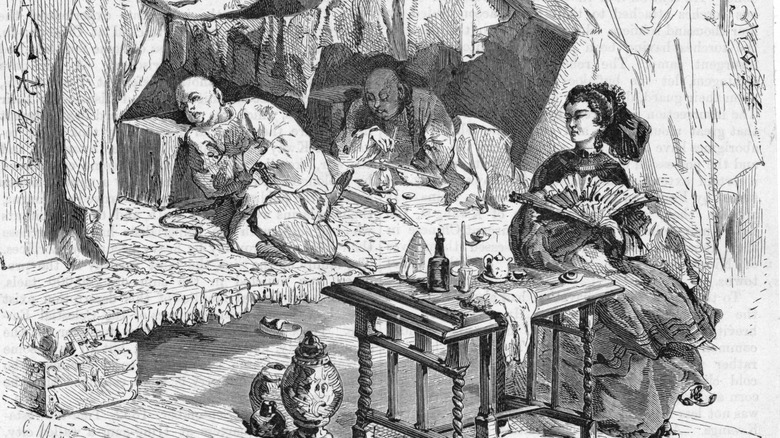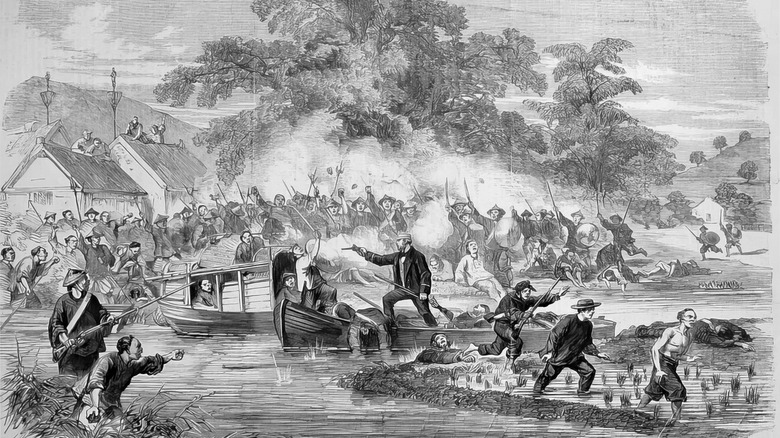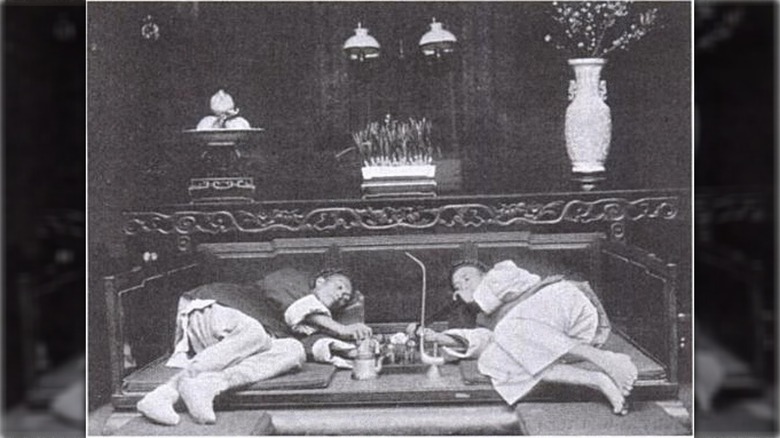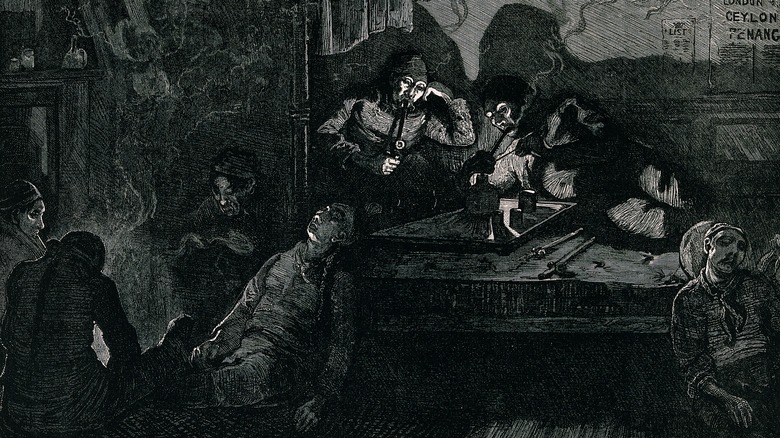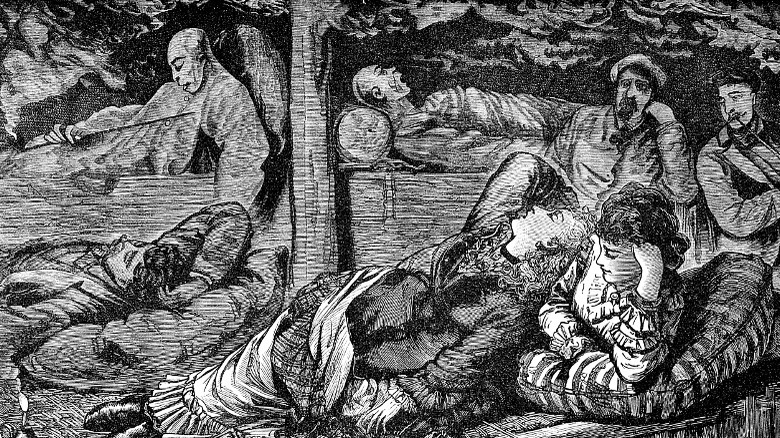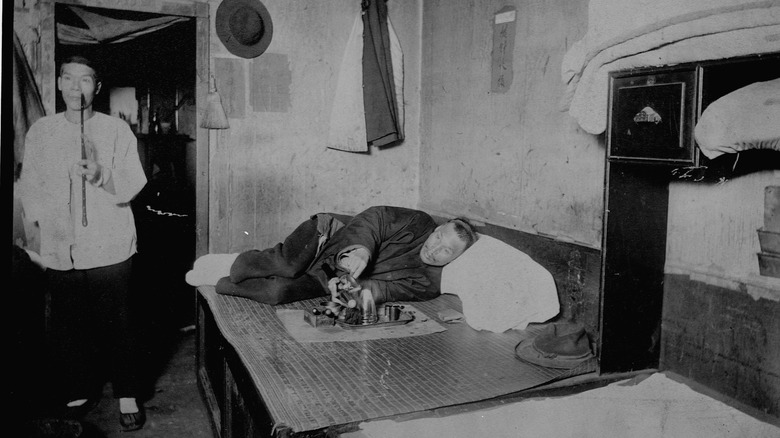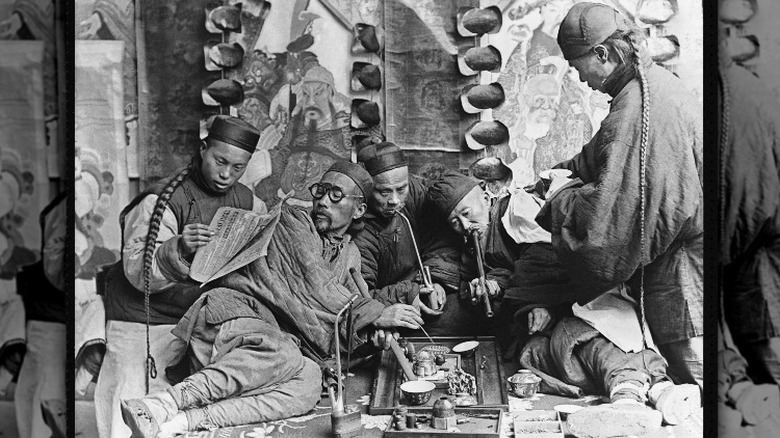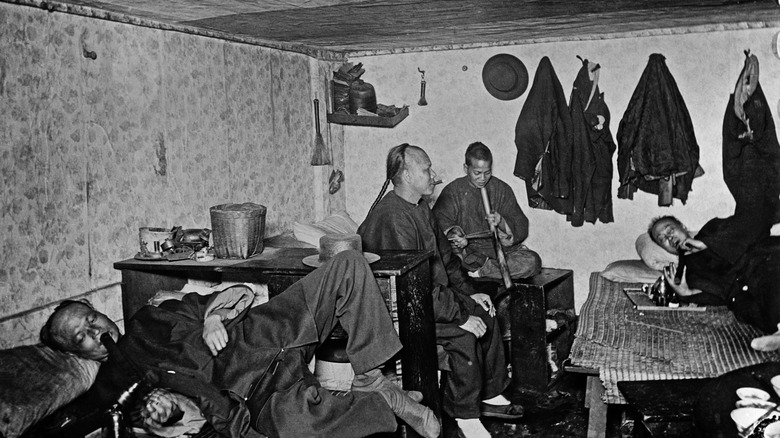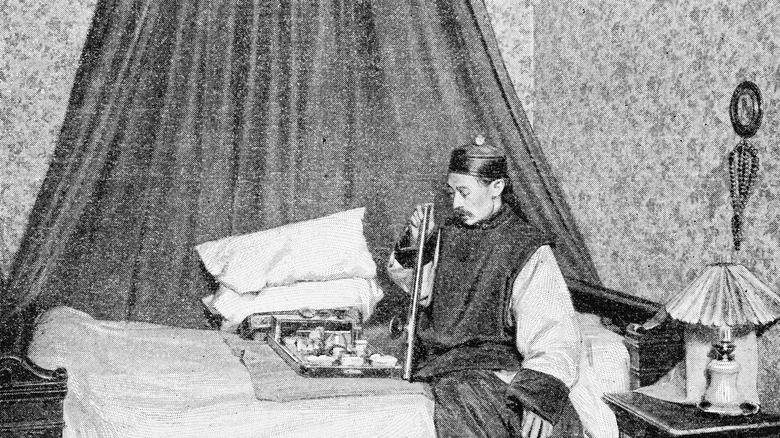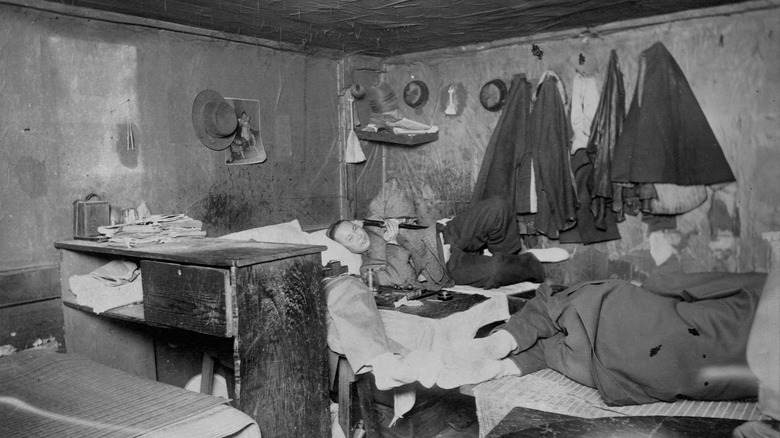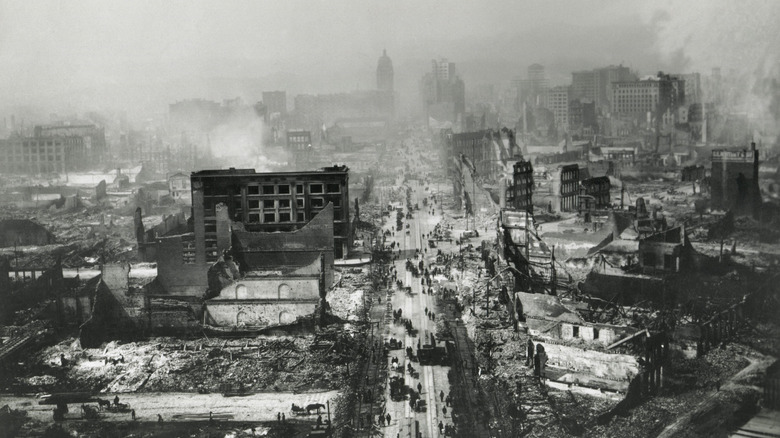What America's Opium Dens Were Really Like
The history of opiates across the globe is a pretty long one. After all, cultures across different continents and across all of time have recognized opium as a near-miraculous painkiller (via Neurology). It's referenced in all sorts of places across literature and historical records, so to say that it's been impactful on human history is quite an understatement.
When it comes to the United States, it would be fair to say that opium has had a pretty storied history, and not all those stories are particularly positive. While it started seeing usage during the Revolutionary War as a simple painkiller, its prevalence among the public only grew over time. The Civil War saw many instances of soldiers accidentally becoming addicted, because the army might have gotten just a bit too fond of how effectively it could dull the pain of wounds. The number of cases of dependence was only made worse when the combination of the hypodermic syringe and isolation of morphine meant that doctors could directly inject opiates to treat just about any number of maladies.
With addictions growing, the public view of the drug at large began to shift, with a number of communities and establishments coming under greater scrutiny, including the opium den. And while the wider drug problem did play a part in those establishments coming under fire, it's also fair to say that there were some far more complicated factors at play, as well.
China and the opium trade
Opium has played a pretty big part in the history of the world, but it was a rather consequential part of Chinese history in particular. And that factor is a pretty big part of the complex opinions later surrounding opium dens.
Around the late 18th century and early 19th century, Western powers (like the U.S.) started to experience rapidly growing appetites for Chinese goods — silk, tea, and the like. Unfortunately for those Western consumers, there wasn't a whole lot that China wanted in exchange. All wasn't lost, though, because there was a pretty hefty supply of opium sourced from nearby India, and Western merchants saw an opportunity to make some profit (via Modern China). Smuggling routes for the drug started cropping up, and demand for it skyrocketed; suddenly, the West had a pretty valuable commodity to trade.
But the outcome of this was far from positive. Not only was the growing demand setting off waves of financial and economic issues for the Chinese government, but that increased demand came largely as a result of growing addiction among the Chinese population. That addiction on its own became a huge problem, sparking social issues on a national scale, prompting the Chinese government to try and tamp down on the opium trade. The British government wasn't happy with that, and the resulting conflict, called the Opium War, ended in a pretty humiliating defeat for China — a defeat that came to be conflated with the fall of the Qing Dynasty.
What were opium dens?
Now let's get the simple question out of the way. Opium dens, very generally speaking, were establishments built into back rooms and basements (via PMLA) where visitors could settle down with the aforementioned drug and a pipe, then smoke to their hearts' content. Quite a few of them started popping up in large cities on the west coast (San Francisco in particular had quite the association with them), though as time passed, they could be found in smaller cities as well. Similarly, their clientele expanded quite considerably throughout the years; though they were typically run by Chinese immigrants, people from all walks of life could be found smoking there. White Americans frequented them often, and you could find male laborers and teenage girls alike enjoying the experience.
And, yes, they were also illegal — or, at the very least, they were eventually made illegal when wider parts of American society caught wind of what was happening. That said, they didn't seem to be regarded as shady, dangerous, underground establishments that operated in secrecy. On the contrary, visitors sometimes saw them as something akin to tourist attractions — experiences that they wanted to try out for themselves.
The negative view surrounding opium dens
When you start looking into historical accounts of opium dens — as well as both their patrons and proprietors — a lot of what you read isn't pleasant. In general, the descriptions paint a picture of a tiny, cramped space in a basement or shoved into a backroom (via PMLA). The ceilings were especially low, and there was general messiness and clutter that could be found all around. Not only that, but the rooms were dark — they were illuminated by only a couple of lamps, and the walls themselves were supposedly even blackened with smoke.
What's more, many accounts from the time tend to link the opium dens pretty explicitly to sin and debauchery. A New York police chief likened the effects of opium to "either paradise of hell," and a San Francisco reverend spoke of the atmosphere, saying, "It is like being in a sepulcher with the dead" (via Found SF). An observer named George Fitch went even further than all of that, claiming, "When a [white] man or woman falls under the bondage of opium, self-respect is lost" (via PMLA).
All that said, though, the identities of the people writing these accounts should be considered before taking them at face value. Upper-class Americans prized purity, cleanliness, and the like, and were almost against everything that the dens were and stood for on principle. Descriptions provided by members of that group probably wouldn't be pretty, for a number of reasons.
[Featured image by Wellcome Images via Wikimedia Commons | Cropped and scaled | CC BY 4.0]
Claims of manipulation
The claims made by opponents of opium dens got really intense at points, throwing out some pretty serious accusations.
A lot of that was based on the fact that these opium dens were visited by a wide variety of people, and that group included a fair few young women. And so, in the process of painting an extremely negative picture of the dens — and those who operated them — observers speaking from high positions of authority claimed that the women were being manipulated and basically abused. An actual grand jury report was the one to make this claim: "White girls ... are enticed into these opium dens, become regular habitues, and finally are subject wholly to the wishes of the Oriental visitors" (via Found SF). Police reports more or less validated a similar narrative, making specific warnings that young women were at risk, and hysteria began to ensue, stories spreading of girls being lured into the dens and forced into sex acts against their will.
The whole image was, to put it lightly, horribly racist, but unfortunately unsurprising for the time period. Anti-Asian sentiment was really high in the late 1800s — something evident in both legislation as well as in things like political cartoons and general perception, where Chinese immigrants were universally painted as predatory men desperate to steal away (generally white) American women. Frankly, it's hard to overstate how unfair and unjust all of that was.
Were the dens all that bad?
If you're wondering whether or not the opium dens were quite as bad as so many reports seem to paint them, then it's important to know that racial tensions were undoubtedly high and played a big part in the entire situation. Or, in other words, there are other reports about the dens that present them in a very different light.
In short, the dens might have actually been quite comfortable, and perhaps surprisingly so, even to people at the time. Per PMLA, a photographer actually went to visit one of these dens, and he did so having heard that they were tiny, cramped places, filled with people too high on opium to be anywhere near clear-minded. But his actual photos (shown above) portray a very different scene: a rather spacious establishment with plenty of room to lay down comfortably while smoking, and a Chinese man who wasn't drugged into unconsciousness but rather looked happy and almost proud to be photographed. Other reports corroborated the world shown in these images, describing a cozy room and atmosphere more akin to a lounge than some criminal hotspot. Everything you needed — the opium itself, pipes, and such — was provided, and there were even attendants present to help out. People were free to stretch out and could safely stash their personal belongings in something called an opium pillow.
Then, on top of that, there's the simple fact that, even with all the negative press, people were still frequenting the dens.
Opium dens led to much wider discussions on race
With opium dens being so heavily linked to Chinese immigrants, it only followed that 19th-century writers would start spewing some heavily racist conclusions about an imagined link between race, addiction, and civility on the whole.
It's a long-winded and somewhat meandering point, but in effect, America (and Western Europe) was often painted as the pinnacle of progress, industry, and modernity. In contrast, Asia was often painted as somewhere wholly and unimaginably different. "Exotic," even, if you want the exact word that was used. Continuing down this line of logic, addiction was explicitly tied to Asian and Middle Eastern nations — a relic of an ancient past that Eastern nations were apparently content to linger in, while the West was too busy with progress to indulge in that sort of thing. That conclusion widened further, with the assertion that Eastern nations were inherently barbaric and backward as a result, valuing things like gluttony that just couldn't function in modern society; taken even further, the argument claimed that people from Asia and the Middle East were themselves too barbaric to function at all in the shiny modern marvel of the Western world.
Or, if you want all of that summed up in a single, quick sentence, then you can look to William Rosser Cobbe's view of those who ran the opium dens: "They are ignorant, illiterate, vulgar, brutal, and wicked" (via American Studies).
Blame wasn't equally distributed
America has had a drug problem for a pretty long time, and to think that it's been fully fixed is somewhat shortsighted. Throughout the years that addictive drugs have been discussed in the U.S., even up to the present, things like age and race typically skew public perception, and not all of those who take drugs are treated equally.
That was very much true when it came to the opium dens, and entire conversations about morality and redemption were had, with many of them tending to favor white Americans. The argument basically held that Americans who frequented opium dens were only victims (via American Studies). American society was just so stressful and busy, with those hard-working citizens so involved in making the country better that they should be given some slack. It was only natural that they would be seduced by the promise of catharsis and relief. So while they were, supposedly, dishonoring themselves, that wasn't grounds for any judgment on their morals.
In contrast, Chinese immigrants weren't given any sort of benefit of the doubt. Rather, they were thought to have no place in American society, and since they apparently didn't contribute to the economy, they had no reason to smoke opium. It was voluntary, and thus, it was grounds for a judgment on morality.
There are two sides to every story
Accurate reports and descriptions of opium dens in the late 1800s are somewhat few and far between. Then, on top of that, there's another factor to consider: Namely, that many of those writings are biased. And those writings come often from white Americans who saw Chinese immigrants in a negative light. But what about the Chinese immigrants themselves?
There isn't a whole lot when it comes to first-hand accounts from those immigrants, but an article from PMLA did speculate just how different that viewpoint would have been. Basically, while Americans frequenting the opium dens had free reign to see the drug as a purely cathartic release, for Chinese immigrants, the drug had a much darker association. The opium trade of the 19th century was somewhat forced onto China, largely just so that Western nations could benefit. And then the drug — and addiction to it — tore apart and weakened Chinese society. Attempts to handle the problem by cutting off the trade only led to aggression and war, which resulted in the fall of the Qing Dynasty, and Western nations ultimately benefited from all of it. In fact, where Americans saw opium as an Asian drug, in actuality, it's easy to argue that the Chinese people saw it as a Western drug. That's a lot of history to consider, and none of it is anywhere near cathartic.
Attempts to control opium dens
It's very, very clear that the American public at large began to take issue with opium dens, and so it shortly followed that there were quite a few attempts to close down the dens and control the opium trade more generally. Despite all those attempts, though, there wasn't a whole lot of success.
In San Francisco — a city especially notorious for having plentiful opium dens — police started running drug busts for the first time starting in 1861, but their immediate effectiveness was fairly negligible. (That said, it probably wasn't helped by the fact that said drug busts were rather sporadic and the police still typically didn't care enough to do anything.) Official legislation was even put into place in the late 1860s to try and curb opium imports to the U.S., but they just didn't have much effect. Really, the city wouldn't see much reduction in visits to opium dens until some decades later, when a few Americans were jailed. The dens themselves were even officially made illegal late in the century, and multiple ordinances were passed throughout the 1870s and 1880s, further specifying that it was illegal to use opium recreationally or visit places that allowed for that.
The dens didn't actually shut down as a result of all of those attempts — at least, not immediately. More often, they just moved underground, where they would be easier to hide and could continue to function. In fact, some of them even managed to last well into the 20th century.
The closing of the dens
If police raids and a bunch of official legislation weren't enough to shut down the opium dens on a wide scale, then what actually managed to do such a thing? As it turns out, the answer to that question has relatively little to do with the public outcry that had surrounded opium dens for much of their existence.
When it comes to San Francisco, a city with a Chinatown filled with opium dens, the end of those dens came in the form of a natural disaster. More specifically, it came with the advent of the 1906 earthquake — one of the worst natural disasters in U.S. history, which leveled portions of the city, killed thousands of people and started multiple fires that caused even further damage. Many of the opium dens just didn't get rebuilt in the aftermath of the tragedy, possibly because they were simultaneously hampered by new federal legislation passed in the early 20th century. The years 1906 and 1909 both saw laws passed that severely restricted — then later completely banned — Chinese opium from entering the U.S. at all.
Speaking more generally, though, opium dens across the country mostly just closed due to changes in the times. As the decades passed, interests shifted naturally away from opium and towards other substances like tobacco or alcohol. The diminishing interest saw the dens slowly start to close down, and by World War II, they simply didn't have the presence they once did.
